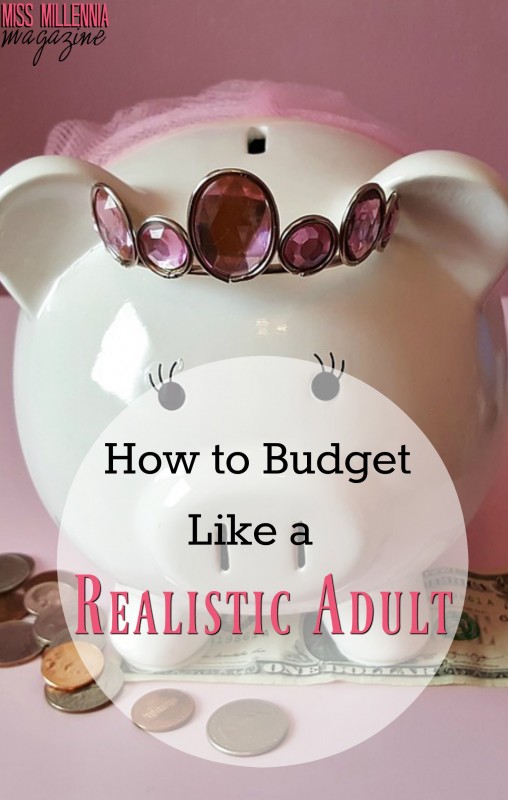How to Budget Like a Realistic Adult
Unfortunately, the days of asking your parents for spending money to go to the movies with your friends are long over. Once we’re in our twenties, we’re expected to have jobs and make money. We have to provide our own spending money, and on top of that, we have to pay for the necessities, like food, rent, and those dreaded student loans. All of this can seem utterly daunting for the young millennial who’s just starting out on her own, but we’ve got you covered. Here are some tips for how to budget like a realistic adult.
1. Use a Banking App
It is so helpful to be able to constantly check up on your financial state. Most banks have an app you can download so that you can frequently check how much money you have in each account. This way, you can track every purchase you make, so you know exactly where your money is going. If there’s a problem, you can also report it to your bank right from the screen. You can easily transfer money between accounts in the app, and deposit any checks by photographing the image right from your phone. That’s one of my favorite features—I no longer have to worry about driving to a bank to deposit my checks before they expire.
2. Keep Track of Your Expenses

If you’ve ever wondered where all of your money is going, spend a few weeks manually logging each expense. You can use a notebook, spreadsheet, or app—the point is just to keep track of everything. After a few weeks are up, analyze your spending. Determine whether each purchase was: necessary and the right price, necessary and more expensive than it should be, unnecessary that you regret, and unnecessary that you don’t regret. Now you’ll know which items you should look for on sale or use coupons on, and which types of items you should avoid in the future because you really didn’t need them. This is also helpful for determining how much you spend each month. Now you can assess how much money you should allot to each spending category, and where you might need to make cuts. You’re all set to create your budget.
3. Create a Budget Guideline
Forbes recommends a 50/20/30 guideline for budgeting, but you can tailor one to suit your individual needs. The important thing, however, is breaking your paycheck into three categories: necessary expenses, financial priorities, and a weekly allowance.
Necessary Expenses
The first number, 50 in this model, refers to your necessary expenses. The goal here is to keep these under 50% of your take home pay every month. These expenses include housing costs, such as paying rent or a making a mortgage payment, utilities, groceries, and transportation costs.
Financial Priorities
The next number is 20. In this guideline, you should allot 20% of your monthly take home pay to your “financial priorities.” These include paying off debt and saving for retirement. It also includes other big financial goals like buying a house, going on a fancy vacation, or starting a business. You’ll also want to put some of this money aside into an emergency savings fund. Forbes recommends eventually putting enough money into the fund to cover three to six months of your necessary expenses, should something catastrophic happen.
A Weekly Allowance

The last number in the guideline is 30, the most fun part of your budget. This refers to the 30% of your monthly take home pay that is dedicated to a weekly allowance. This money can be used for going out with friends, paying for a gym membership, making charitable donations, etc. Forbes suggests taking out this number in cash each week, to make sure you stick to your goal. However, if you feel more confident in your restraint, you can track your allowance on an app or in a spreadsheet.
Of course, this model is just a suggestion. Those of us with lots of student debt, for example, may need to devote more than 20% to financial priorities. The point is just to divide your paycheck into categories. This way, you can figure out how much you should spend on each expense.
4. Download an App Like Mint
Mint is a money-budgeting app that has become pretty popular. You can sync your account with your bank (it’s pretty safe), and see all of your financial information in one place. Your cash, savings and checking accounts, loans, investments, and property are all there. Additionally, you can find out your credit score and check out their ideas for ways you can save money. You can also set goals, such as paying off your student loans, buying a new car, or planning an expensive vacation. Finally, you can create your own budget, with categories ranging from books and supplies to spa and massage. You can even add your own! This way, you can determine exactly how much you want to spend on each item throughout the month and make sure you’re not going over.
5. Set Up a 401(k) Account

Even though it seems like an eternity away, now that we’re adults, we really should start thinking about saving for retirement. It takes a lot of money to be able to retire, so the earlier you start to save, the better! See if your company offers matching—about 40% do—which will help your retirement fund grow even more. You can also start an Individual Retirement Account (IRA). In this account, you pay taxes on the money you contribute now. However, once you retire, you won’t have to pay any taxes when you withdraw the money. Because this is so appealing though, you can only $5,500 a year, and $6,500 a year once you’re 50.
Paying your own expenses and creating a budget doesn’t have to be scary! In fact, it can be kind of fun to look at all of the money you’ve made. You get to determine where to spend it all. Budgeting is certainly a daunting subject for us millennials, but with a little practice, you’ll be handling money like a pro in no time!
Resources: Mint, Forbes, Forbes, Forbes, RothIRA, New York Times
**This article contains affiliate links, and we will be compensated for any purchase made by clicking on them. Thank you for supporting Miss Millennia Magazine!**






